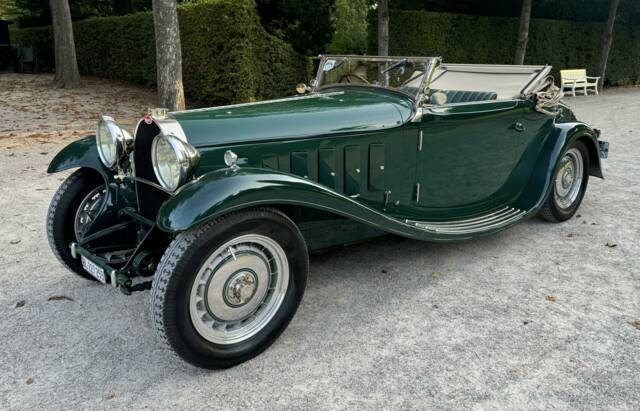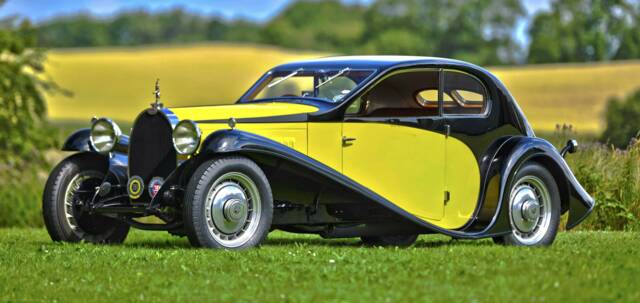Bugatti Type 46 classic cars for sale
Produced from 1929 to 1936, the Bugatti Type 46 sits as the renowned 'La Petite Royale', fusing the engineering prowess of its era with striking design and luxury. Equipped with a 5.4-litre straight-eight engine and sophisticated chassis components inherited from the spectacular Type 41 Royale, the Type 46 offered a balance between spirited touring performance and elegant sophistication. Custom coachwork and opulent finishes made every example unique to its first owner.
Résultats de la recherche



The history of the Bugatti Type 46
Delivered to the public at the 1929 Paris Motor Show, the Bugatti Type 46 was created to bridge the gap between the more accessible Type 44 and the monumental Type 41 Royale. Ettore Bugatti leveraged technical achievements from the Royale, including drivetrain and brake innovations, but presented them in a more compact, lighter body. With just under 470 cars produced, the Type 46 offered an exclusive entry into luxury motoring, appealing to international buyers seeking both comfort and technical sophistication from their vehicle. The Type 46 became known as 'La Petite Royale', paying tribute to its connection with Bugatti’s grandest car while providing a driving experience focused on agility and refinement.
Model history
The Type 46 replaced the Bugatti Type 44 and was positioned directly below the exclusive Type 41 Royale. Designed as a high-class touring car, its engine was a short-stroke version of the massive Royale straight-eight, sharing much of its mechanical base. The car's robust rear-mounted gearbox and luxury appointments set new standards in the segment at the time. In 1930, the supercharged Type 46S joined the lineup, but limited to only 18 units built. The model series later led to the sportier Type 50 and its derivatives, including racing-focused and coupe versions. Each evolution expanded upon the technical and driving characteristics pioneered by the original Type 46.
Highlights of the Bugatti Type 46
- 5.4-litre straight-eight engine with single overhead camshaft
- Mechanical components largely derived from the Royale, including chassis, brakes, and transmission
- 140-inch wheelbase for excellent long-distance stability
- Wide choice of bespoke bodies, from formal saloons to elegant cabriolets, by leading European coachbuilders
- Noted for solid construction, lavish detail, and superior materials in both interior and exterior
- Recognised for agility, comfortable ride, and capable acceleration, the Type 46 was a sophisticated answer to luxury motoring demands of the early 1930s.
Technical data
Special Editions and Collectible Models
A notable variant was the Type 46S, introduced in 1930 and equipped with a supercharger to raise output to 160 bhp. Only 18 Type 46S units were ever produced, making them particularly rare. Many Type 46 examples received unique, one-off coachwork from prestigious ateliers, ensuring nearly every surviving car today is a singular piece.
Weak Spots and Common Issues
While no detailed weak spots are listed in the available data, owners and buyers should pay close attention to the condition of complex mechanical components that share heritage with the larger Royale. Special attention should be paid to the operation and integrity of the rear-mounted gearbox, braking mechanisms, and old coachbuilt body components, especially due to their bespoke nature and the age of materials used.
Engine and Performance, Transmission and Handling
The Bugatti Type 46 delivers a refined ride, with strong and smooth acceleration thanks to its powerful eight-cylinder engine. The long wheelbase provides notable stability at speed, and the car’s rear-mounted gearbox contributes to neutral weight distribution, benefiting both ride comfort and handling. Reviews from period and modern classic enthusiasts cite a perfect combination of smoothness, robustness, and comfort, with a capability for long-distance touring unmatched by many competitors of the era. - Type 46: 5.4-litre, 8-cylinder, 130 bhp
- Type 46S: 5.4-litre, 8-cylinder, supercharged, 160 bhp
- Bodywork by Ateliers such as Vanvooren, Weymann, and others
- Bespoke interiors and exteriors were typical, making each model unique
Interior, Comfort, Exterior and Design
Each Type 46 was delivered as a bare chassis to the client’s chosen coachbuilder, resulting in highly individualised designs. Distinctive styling cues included flowing Jean Bugatti-inspired fenders, an unbroken beltline, and substantial 20-inch wheels echoing those of the Royale. Interior appointments set these models apart: wood inlays, high-quality leathers, Wilton carpeting, and detailed instrumentation. Many examples included optional sunroofs, bespoke luggage solutions, and custom paintwork. The ‘La Petite Royale’ moniker reflects the substantial presence and finish of these automobiles, even in the less formal open-bodied styles.
Other relevant features
International clientele of considerable means not only commissioned exclusive coachwork but often specified advanced accessories for the period, such as custom trunks, picnic sets, and in some cases, inbuilt radios or passenger intercom systems. These optional extras, paired with the unique designs, cement the Type 46 as one of the most personal pre-war luxury cars.
Summary
The Bugatti Type 46 succeeded in delivering superlative engineering, luxury, and customisation options, establishing itself as a mainstay for discerning buyers during its production years. Today, it stands as the focal point of both historical and market demand in the pre-war Bugatti segment, with every example representing an artefact of bespoke automotive craftsmanship from the 1930s.


